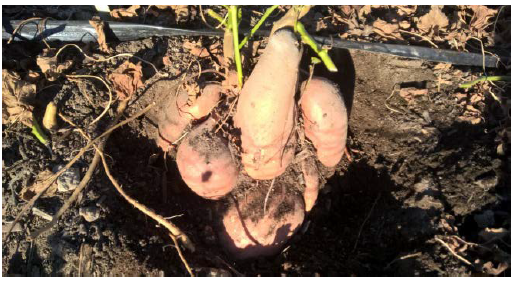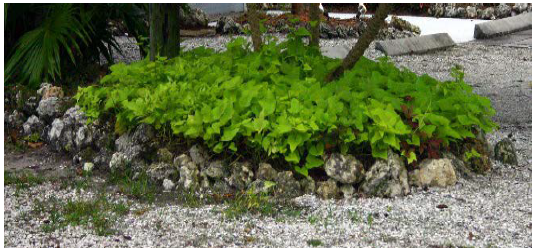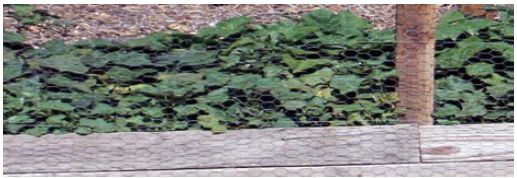INTRODUCTION
Sweet potatoes grow easily, taste good and provide excellent nutrition. Often, people confuse sweet potatoes with yams (Dioscorea) which are perennial tropical vines. Most yams sold in the U.S. are sweet potatoes (Ipomea batatas), a member of the morning glory family. Sweet potatoes like a hot growing season, making southern Nevada an ideal place for them.
The fleshy edible root grows underground with beautiful green and purple leaves above ground. Sweet potatoes originate from the South American continent (Lebot, 2008) and come in many different colors: purple, orange and white fleshed. The plant is not a true potato (Solanum tuberosum), which is a member of the nightshade family.
CULTIVATION
Sweet potatoes grow well in southern Nevada, and particularly like our long, hot days. Planted in late March through early June, they require soil temperatures above 65 F to initiate growth. Most plants begin from “slips” or sprouts from last year’s fleshy roots or vine cuttings. Slips can be ordered through seed catalogs or from suppliers on the Internet. For an even crop size, place slips 6 inches apart with one node aboveground and apply a high-phosphorus starter fertilizer according to label directions to promote root growth. The young plants grow rapidly and completely cover their area with the prolific leaves. These plants need a large amount of space, so rows need to be spaced 36 inches apart, and watered three times a week or as needed, depending on the temperature.
Planting sweet potatoes in raised rows helps drainage. Relatively dry soils help growth. After about 30 days, apply 8-8-8 fertilizer, 3 pounds per 25 row foot.
In 90 to 120 days, sweet potatoes can be removed from the ground, depending on the variety. First check by gently digging underneath the plant and root but not detaching until it is the right size (similar to the size found in the produce section of the grocery store). If not consumed right away, the tubers need to stay dry (not washed) until ready to cook. Washing can damage the skin promoting rot. Sweet potatoes need to be stored out of direct sunlight and rain, and at temperatures of about 85 F for about a week to cure. After curing, place them in a dry, cool place (58 F – 60 F). If they’re kept too cold, the root develops a stringy texture. If they’re kept too hot, they will rot.
Fortunately, few pests bother sweet potatoes. Wireworms and root-knot nematodes can cause problems for the tuberous roots that form underground. Information regarding nematodes can be found in Soil Solarization to Control Garden Pests on Fact Sheet 08-29 at Soil solarization to control garden pests. Growing disease-resistant varieties purchased from reliable nursery sources will help prevent most disease problems. A two-year crop rotation also reduces disease problems. Avoid using transplants that have black rot on lower stems.

Ready to harvest sweet potatoes.

Sweet potatoes grow best in raised beds with organic soils in the desert.
VARIETIES
Many varieties, such as the popular Beauregard, grow very easily. At the Southern Nevada Research Center, Beauregard produced the largest crop out of the 5 trial varieties and had very little damage due to insects and pests. Carolina Ruby has a nice flavor, and growth was satisfactory. The lighter colored sweet potatoes produced a smaller yield. However, they are very flavorful. These lighter varieties include Vardaman, Nancy Hall and Bunch Porto Rico.

Sweet potatoes can be used as a garden ground cover if the bed is improved with organic soil.
TOTAL POUNDS (12 plants of each variety):
Beauragard 46.2 lbs
Porto Rico 24.2 lbs
Carolina Ruby 8.6 lbs
Vardamon 28.1 lbs
Nancy Hall 5.4 lbs
NUTRITION
The leaves, stems and roots of sweet potatoes serve as nutritious food. The leaves are high in protein and can be used as sautéed vegetables and in soups. A baked sweet potato supplies twice the recommended daily amount of vitamin A, over one-third of the recommended amount of vitamin C and 10 percent of iron. Sweet potatoes have more dietary fiber per serving than oatmeal.

In areas with high rabbit and rodent populations, ½ to 1 inch poultry wire is needed for protection.
CONCLUSION
Sweet potatoes easily grow in the desert and provide necessary vitamins and nutrients. By implementing the proper gardening techniques, everyone can enjoy the tasty treat.
REFERENCES
Lebot, V. 2008 Crop Production Science in Horticulture, 17: Tropical Root and Tuber Crops: Cassava, Sweet Potato, Yams, and Aroids.
Ishida, Suzuno, Sugiyama, Innami, Tadokora, Maekawa. 2000 Nutritive evaluation on chemical components of leaves, stalks, and stems of sweet potatoes. 68:3. 359-367
Home & Garden Information Center


